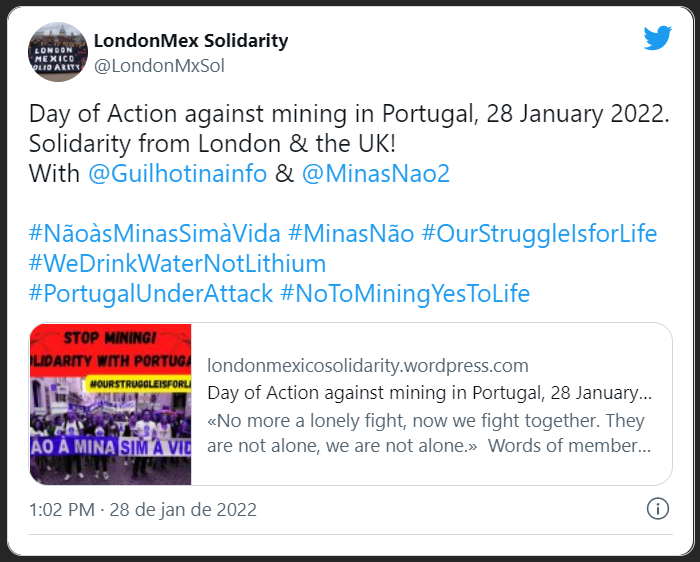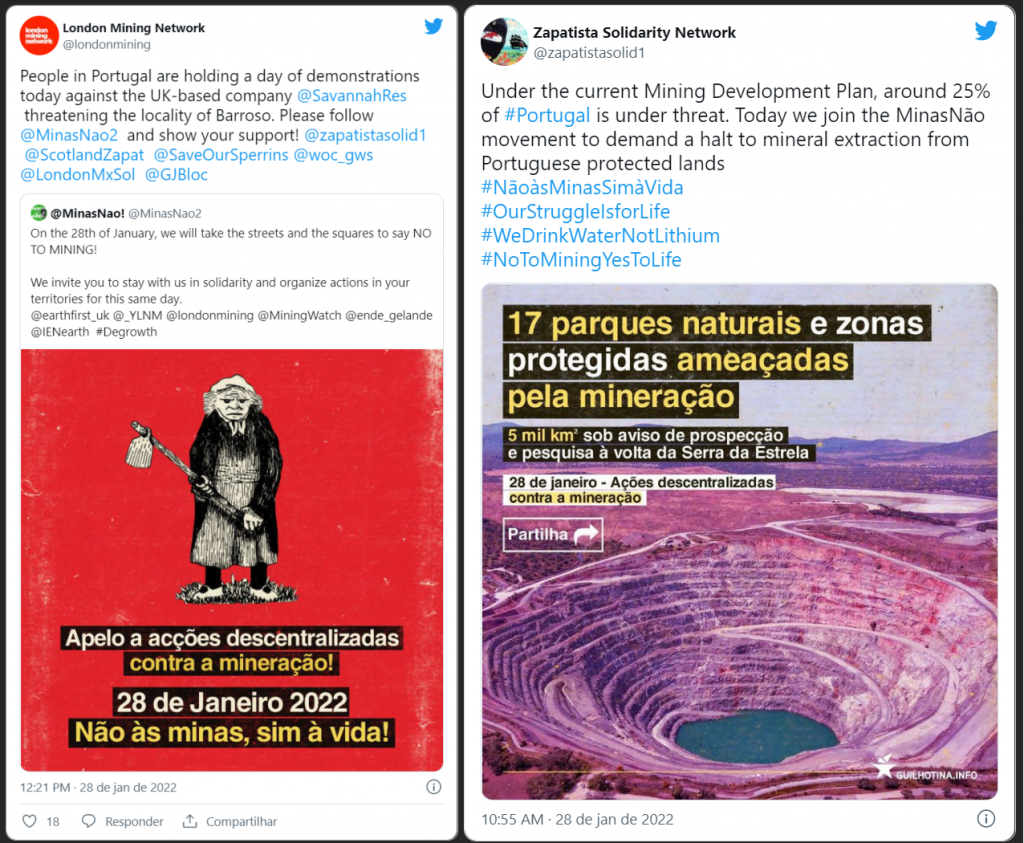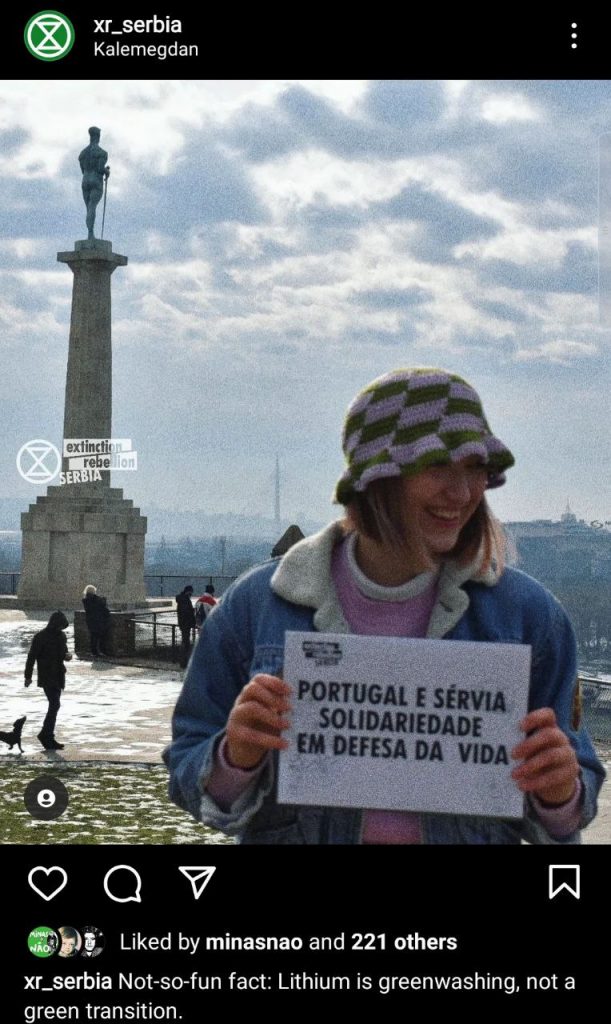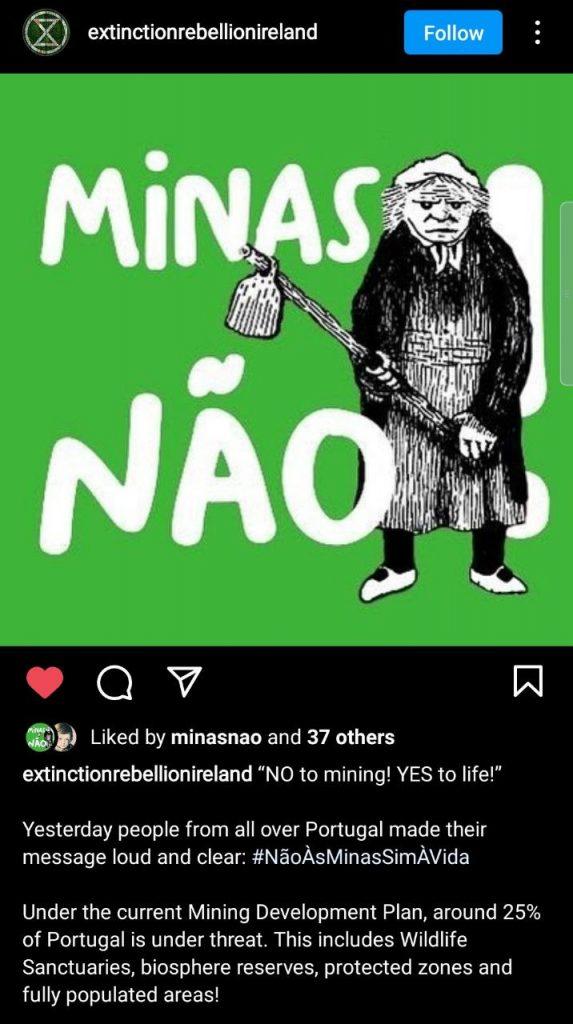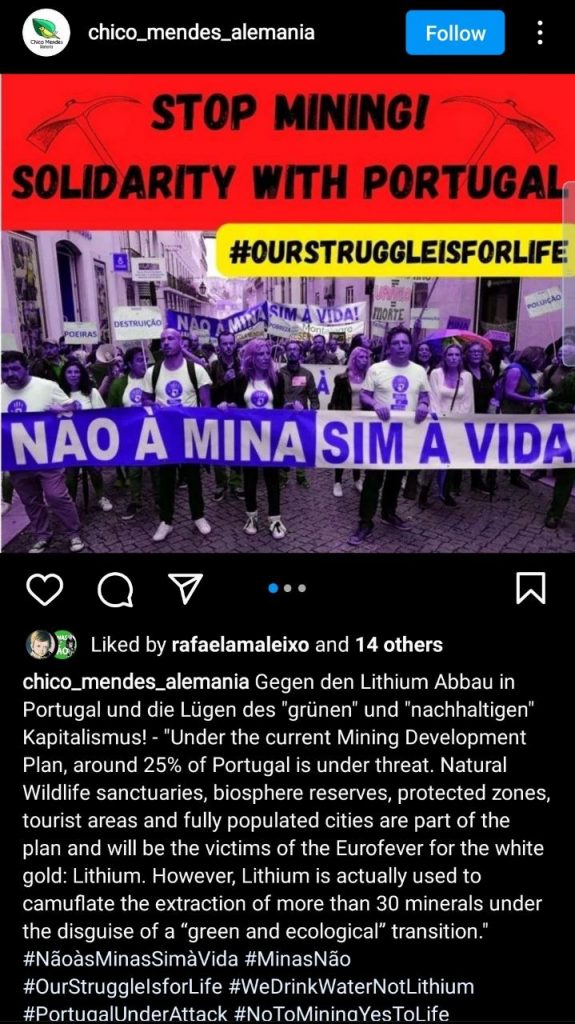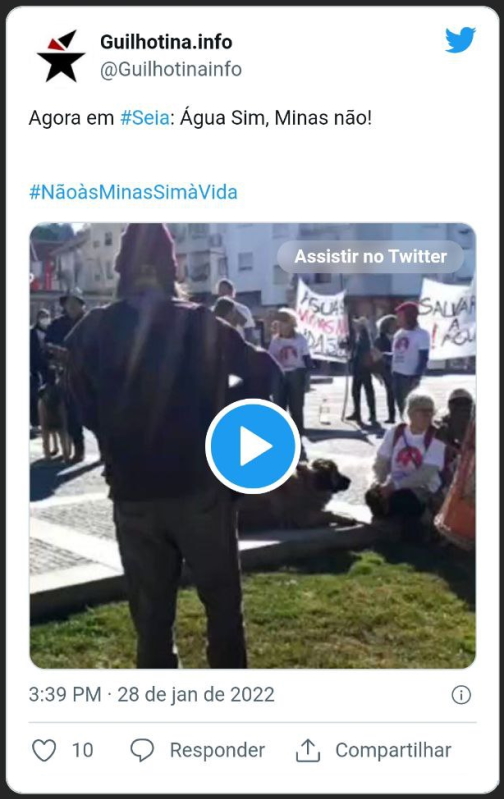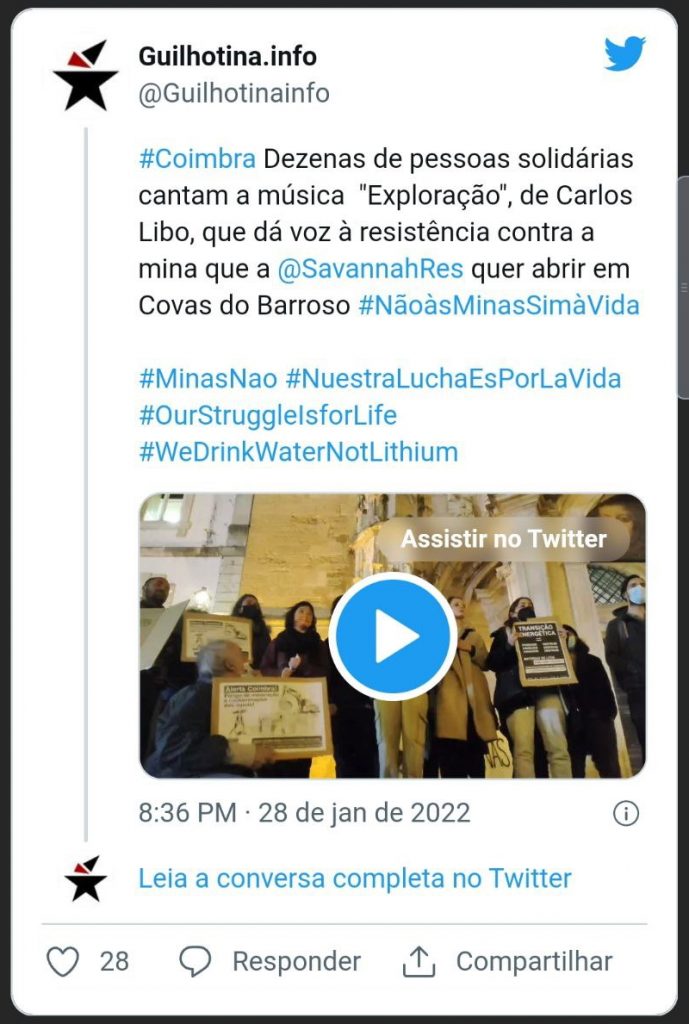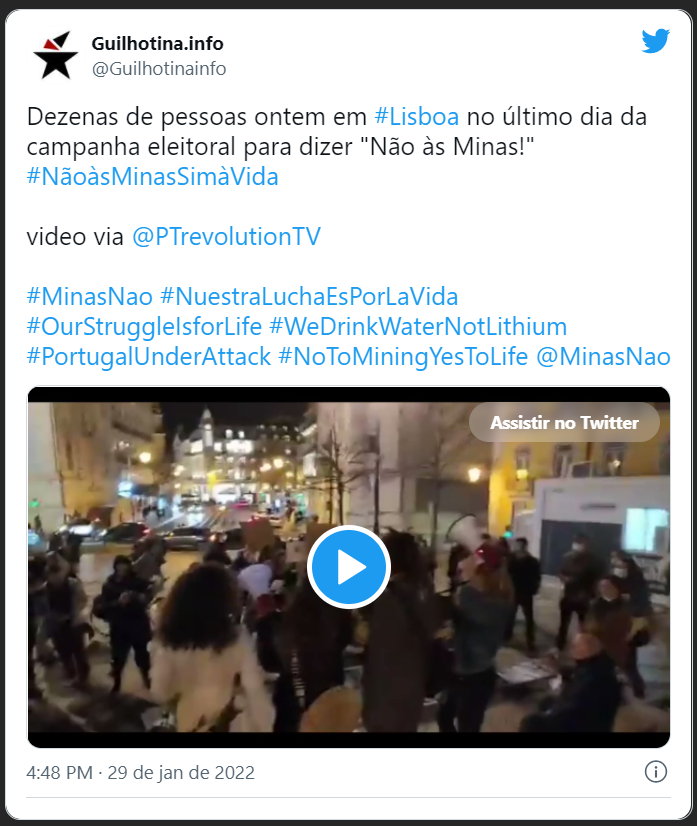Portugal // Wave of actions against mining from north to south~ 20 min

By Guilhotina.info
Under the current Mining Development Plan, around 25% of Portugal is under threat. Natural Wildlife sanctuaries, biosphere reserves, protected zones, tourist areas and fully populated cities are part of the plan and will be the victims of the Eurofever for the white gold: Lithium. However, Lithium is actually used to camouflage the extraction of more than 30 minerals under the disguise of a “green and ecological” transition.
(from here)
On January 28th, people in over a dozen locations across Portugal joined in a day of decentralized actions against this mining plan, just before National Elections, to scream loud and clear: “No to Mining! Yes to Life!” – #NãoàsMinasSimàVida!
These projects are presented in the name of the fight against climate change but only promise to bring destruction, contamination, poverty and water scarcity, reproducing the capitalist logics of extractivism and privatization of profits while socializing losses.
While the political parties with parliamentary representation, from the right to the left, repeatedly avoided the subject during the electoral campaign, people in cities and villages from north to south took this struggle to the streets in many different forms – people gathered to protest, to spread information, to sing resistance songs, to paint banners or to spread posters and messages against mining around walls, fields and mountains. The media, in a fuzz with the last day of campaign, ignored the mobilizations that cried out a message to the political forces: «it doesn’t matter who wins the electoral theater of January 30th, we will keep struggling for life!»
The elections gave the socialist party, in government since 2015, an absolute majority, making it predictable that this mining development plan would start to move forward in a faster way. Actually, just two days after the election, the portuguese government was already announcing that the international open tender for lithium exploration in several areas in the center and north of Portugal, making a total of 1500 km2, will move forward in the next 60 days.
Below we share photos and videos from the actions that took place in Seia, Coimbra, Lisboa, Barroso, Guimarães, Porto, Oliveira do Hospital, Sátão, Caldas da Rainha, Montemor-o-Novo, Remelhe and Viana do Castelo, and also the messages that came from abroad in solidarity with the anti-mining struggles.
Seia
The first protest happened in Seia, a city by the Serra da Estrela Natural Park. It was called by ContraMineração Beira Serra, a movement that has been resisting for over two years «against the exploration requests and future exploitation of lithium and other minerals in the center of Portugal». Seia is about 10km from one of the areas that the government intends to put to an international open tender for lithium exploration.
In the same region, not so far away, banners were painted and spread around Ervedal da Beira, a village in the municipality of Oliveira do Hospital.
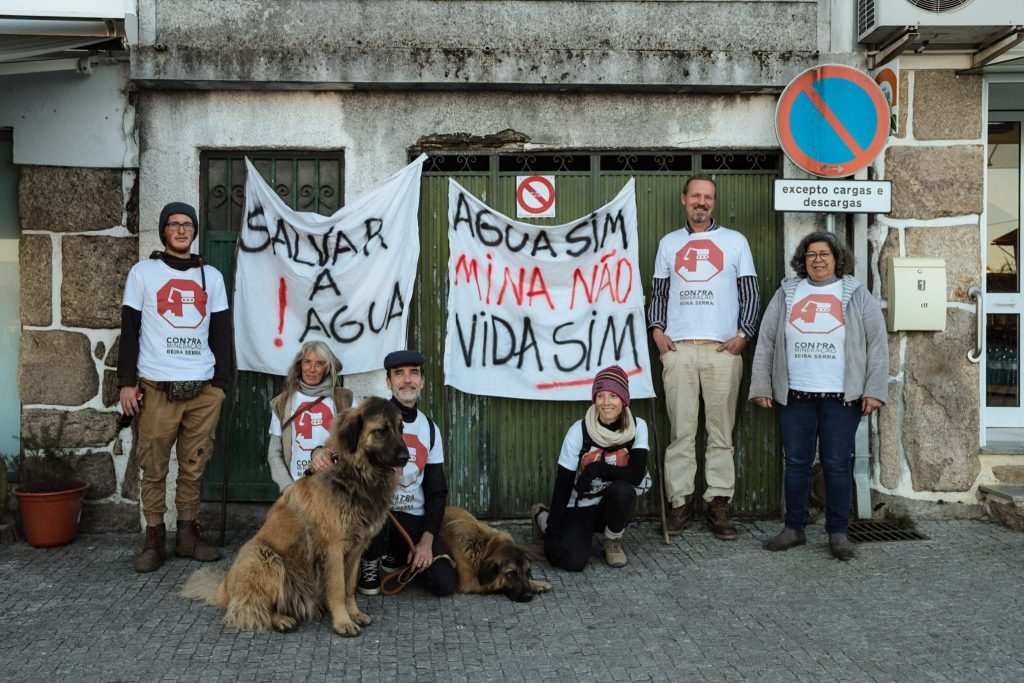
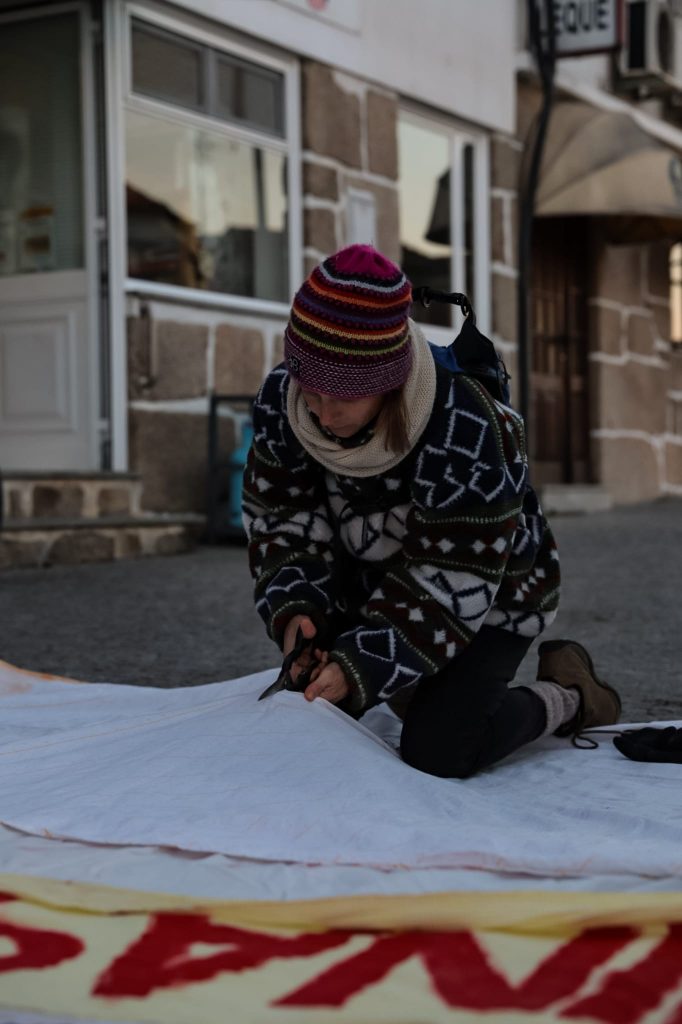
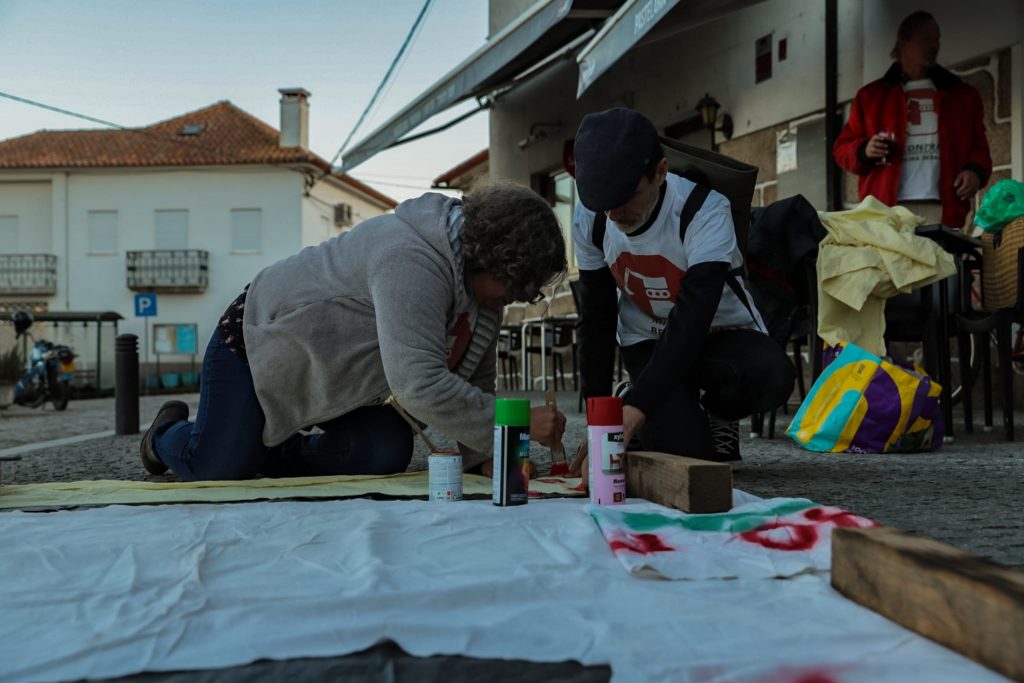

Coimbra
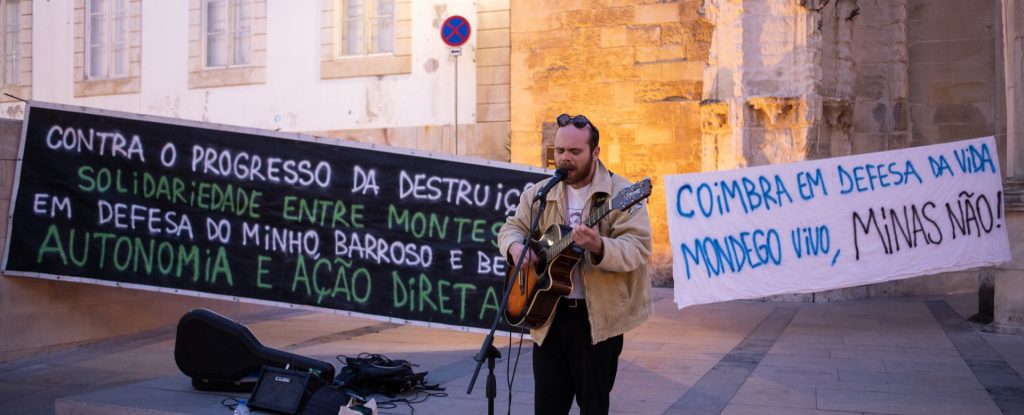
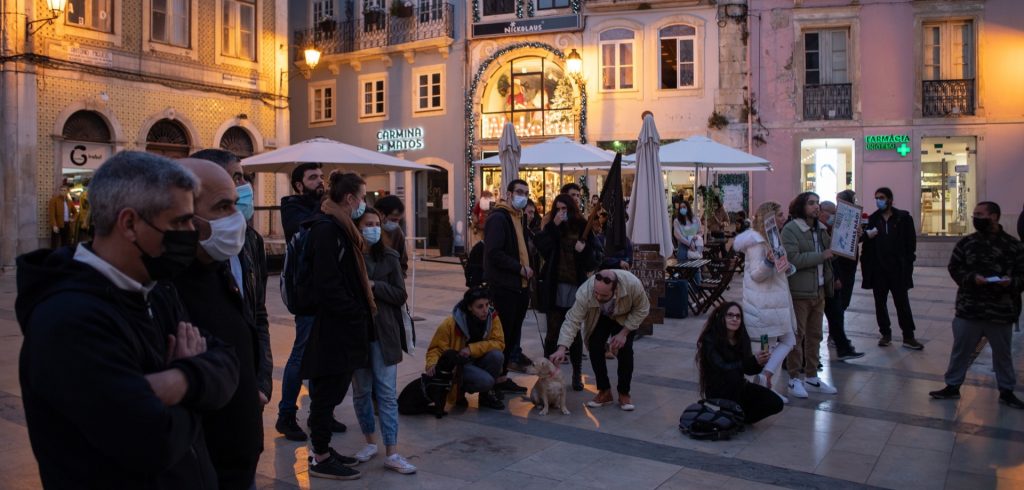
Dozens of people gathered in downtown Coimbra, the third portuguese city, to denounce that the Mondego river is, «in a range of over 30km, under threat of exploration, both from the international open tender for lithium exploration (PPP-L) and from requests by the australian Fortescue for exploration of gold, silver, zync, copper, lithium, tungsten, lead and tin». It was also denounced that just 35km from Coimbra, there is a request for exploration of gold, silver and copper in an area of 11 mil hectares. Its southern limit is very close to the sources of the stream of Mortágua, which flows towards the Mondego river before it crosses the city.
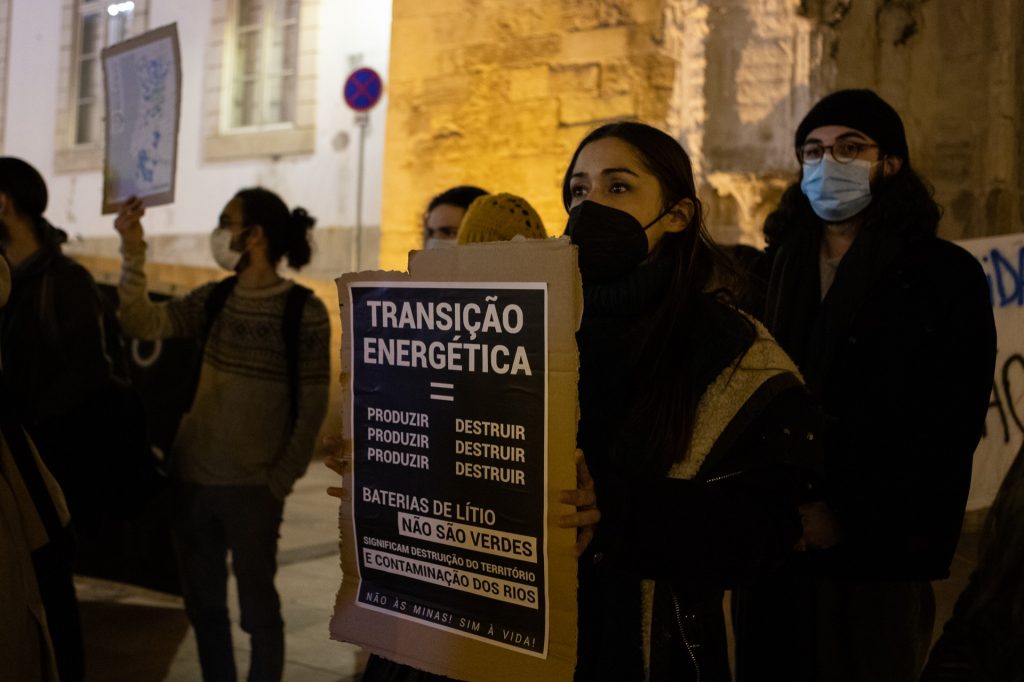
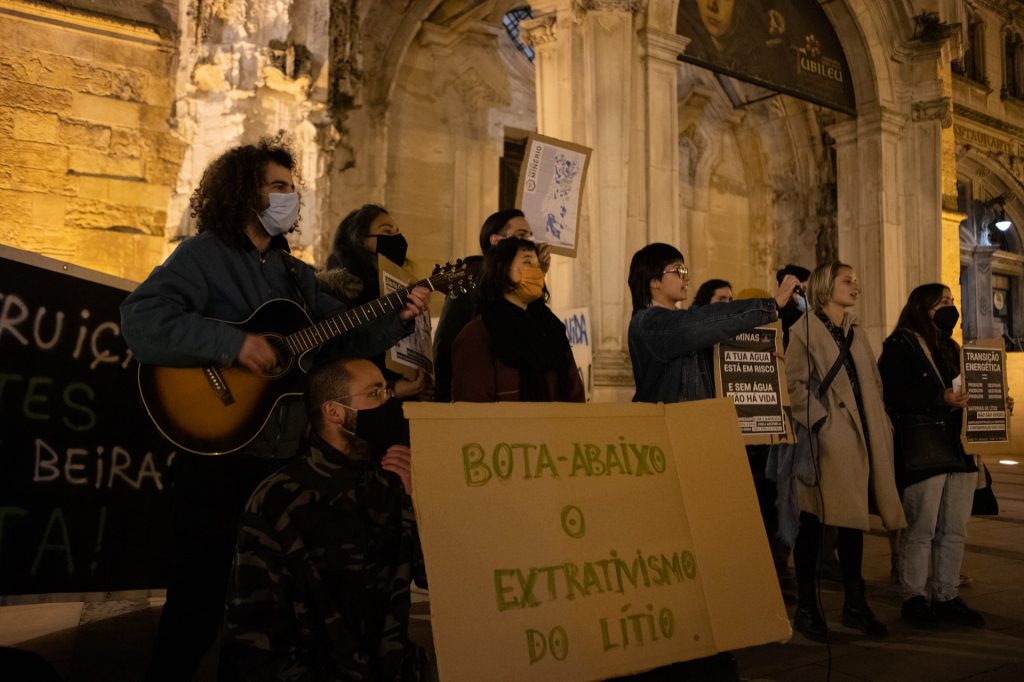
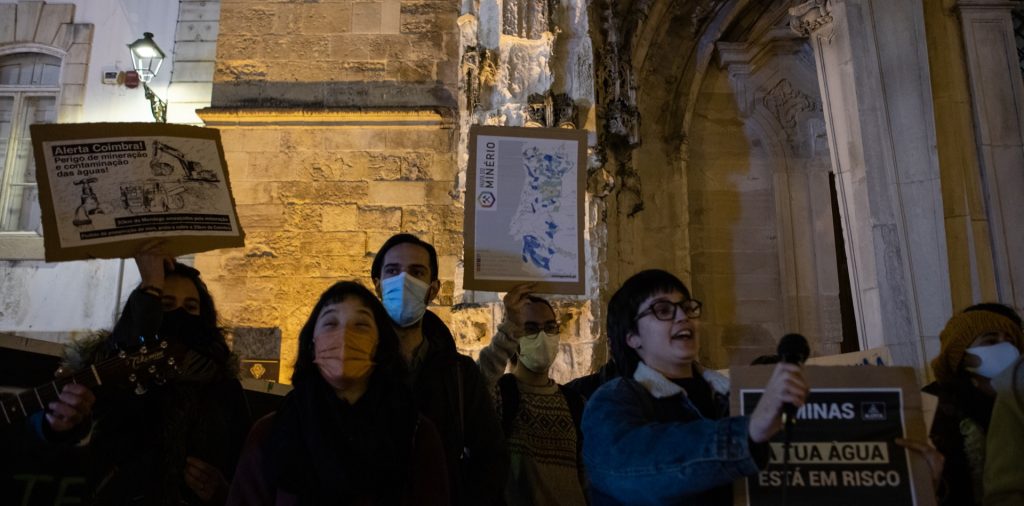

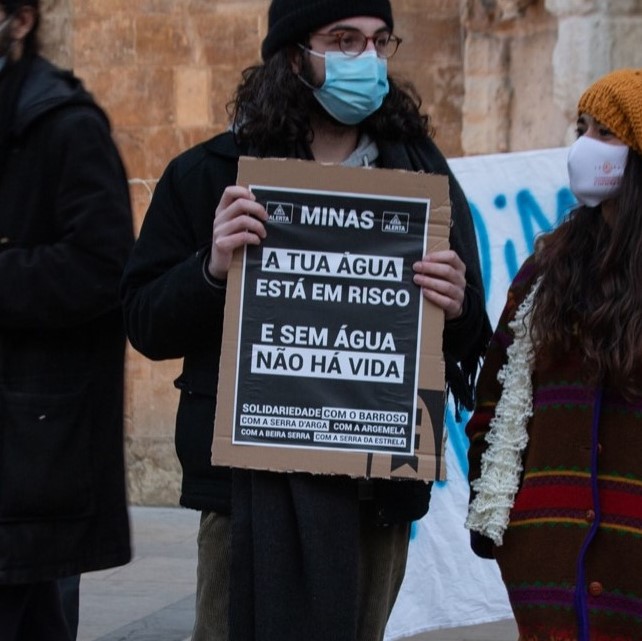
There was music, poetry, flyers and zines were distributed, and an assembly to discuss the next steps of this struggle was announced for February 12th. After two hours, the action ended with people singing an iconic song of the anti-mining struggle in Barroso. “Exploração”, de Carlos Libo, gives voice to the resistance against the mine that the british company Savannah Resources wants to open in Covas do Barroso.
Lisbon
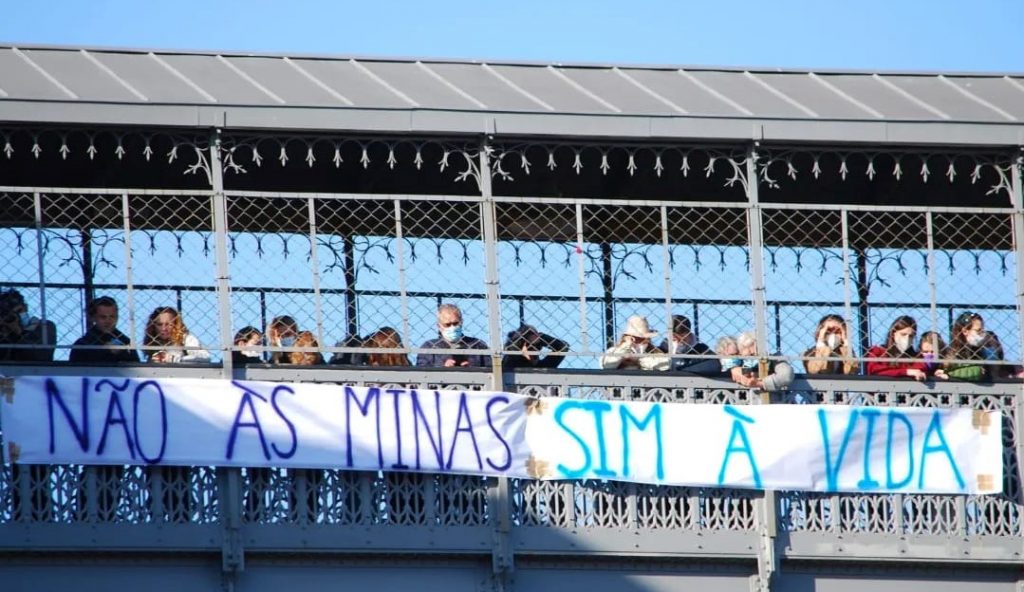
Dozens of people gathered in Lisbon city center to show solidarity with the populations struggling in the countryside of the country and to denounce the direct threat over the capital represented by the Mine of Argemela. This mine is planned for a rural region 200km from this city, but right in the the banks of the Zêzere river, from where the water flowing in the houses of over 2 million people in Greater Lisbon is taken. In Lisbon, the gathering also ended with the singing of another music by Carlos Libo, “Hora de Lutar” (Time to Struggle).
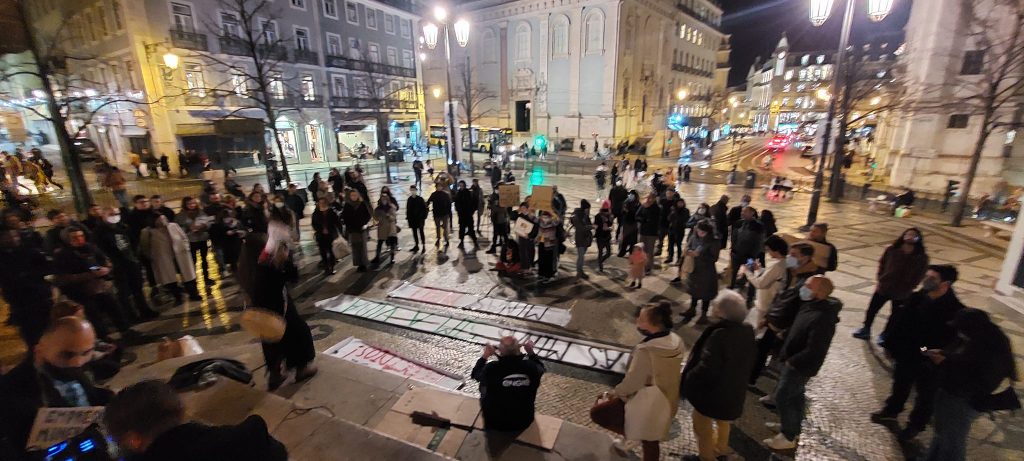

Barroso
In Barroso and also in Gerês, the movements Não às Minas – Montalegre, Povo e Natureza do Barroso and Barroso H2O joined forces to take messages against mining to the most unprobable places.
These and other movements have been struggling against mining projects for over 3 years in Barroso, a region classified by the FAO as a Globally Important Agricultural Heritage System (GIAHS) since 2018 «based on the traditional way of working the land, treating livestock, and on the mutual aid of its inhabitants.» It is the only region in Portugal with this classification and one of the 7 in Europe.
This small region, where ancestral ways of living and relating to the earth survive until today, is made of two municipalities – Boticas and Montalegre. In Boticas, next to the village of Covas do Barroso, the british mining company Savannah Resources wants to open western Europe’s largest lithium mine, with 593 hectars, just about 200 meters away from the closest house.
In Montalegre, a municipality which is also part of the Gerês-Xurés Transboundary Biosphere Reserve, created in 2009, there are also mining projects for lithium (Mina do Romano, in Morgade) and for tungsten, tin and molybdenum (Mina da Borralha, in Salto).
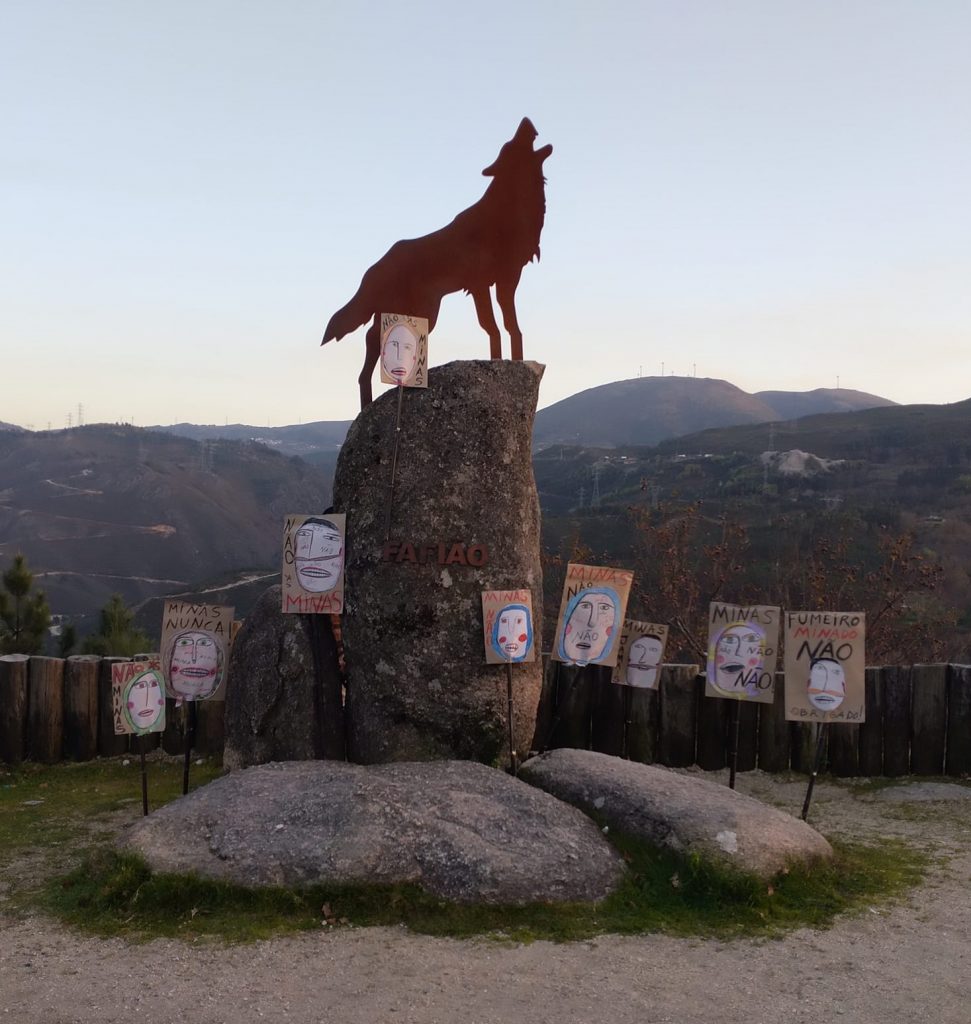
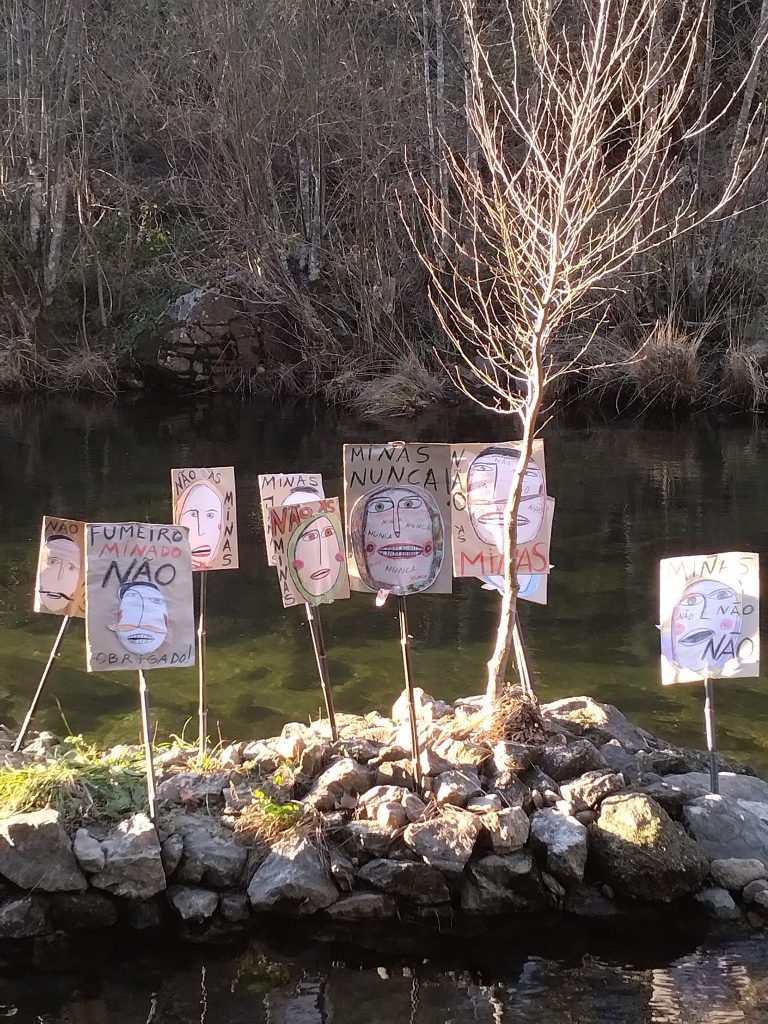
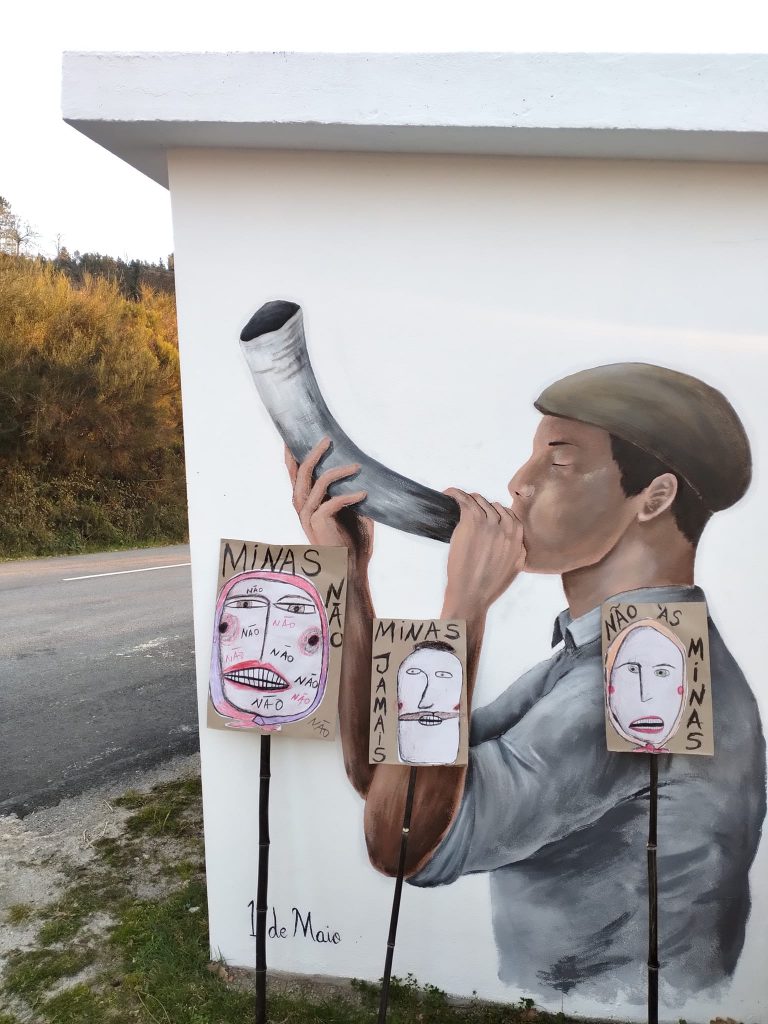
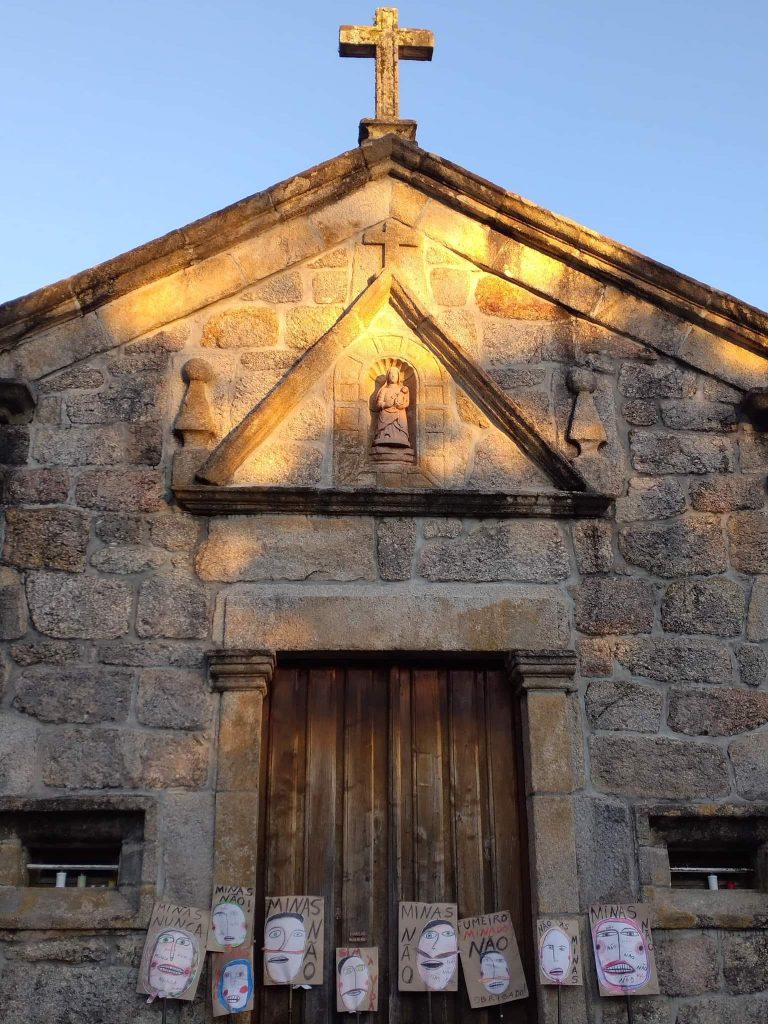
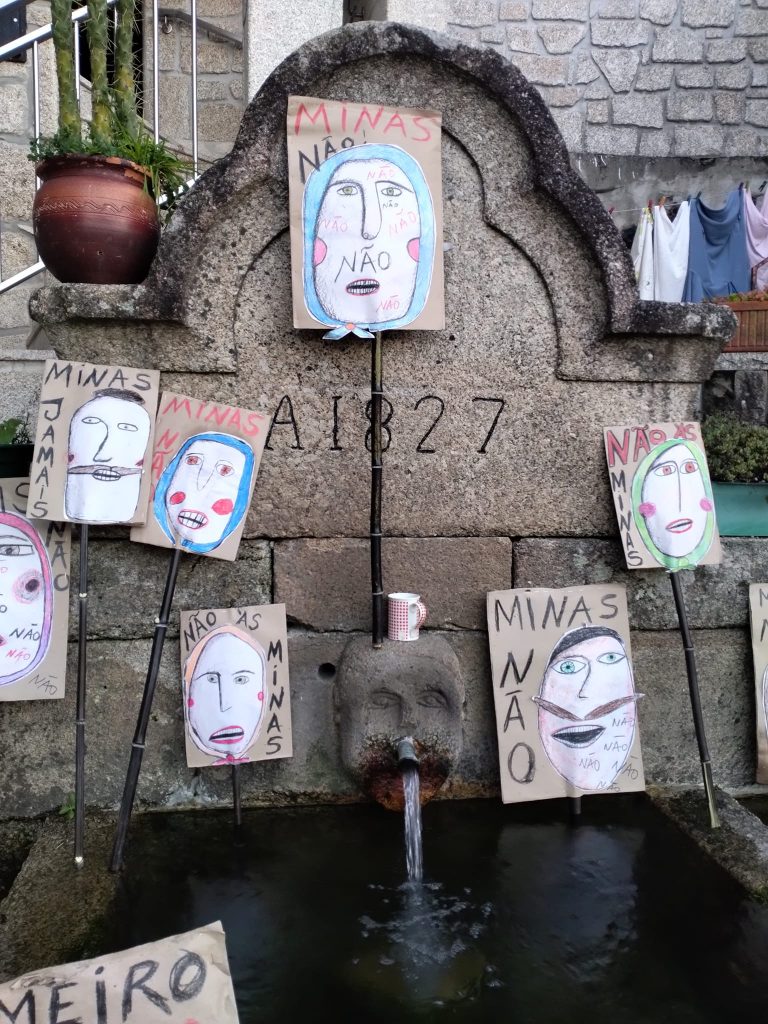
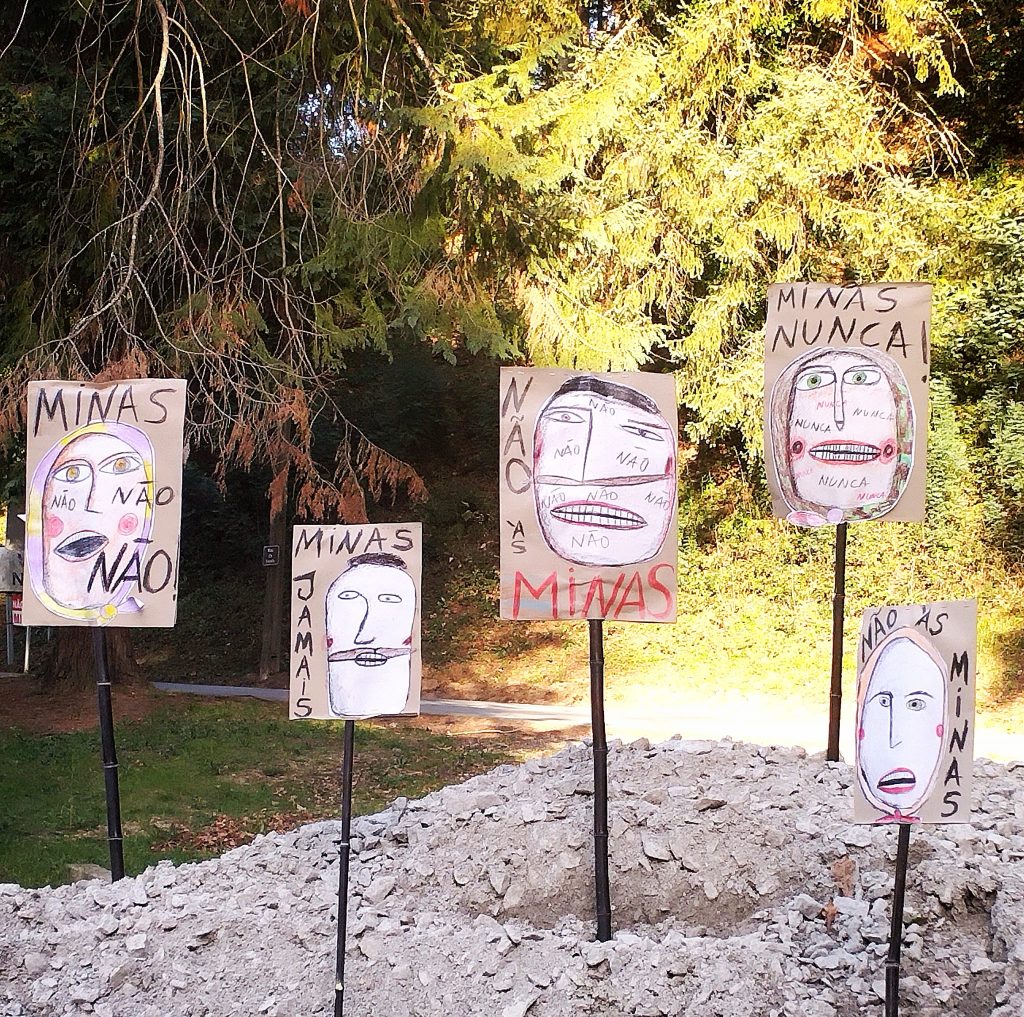
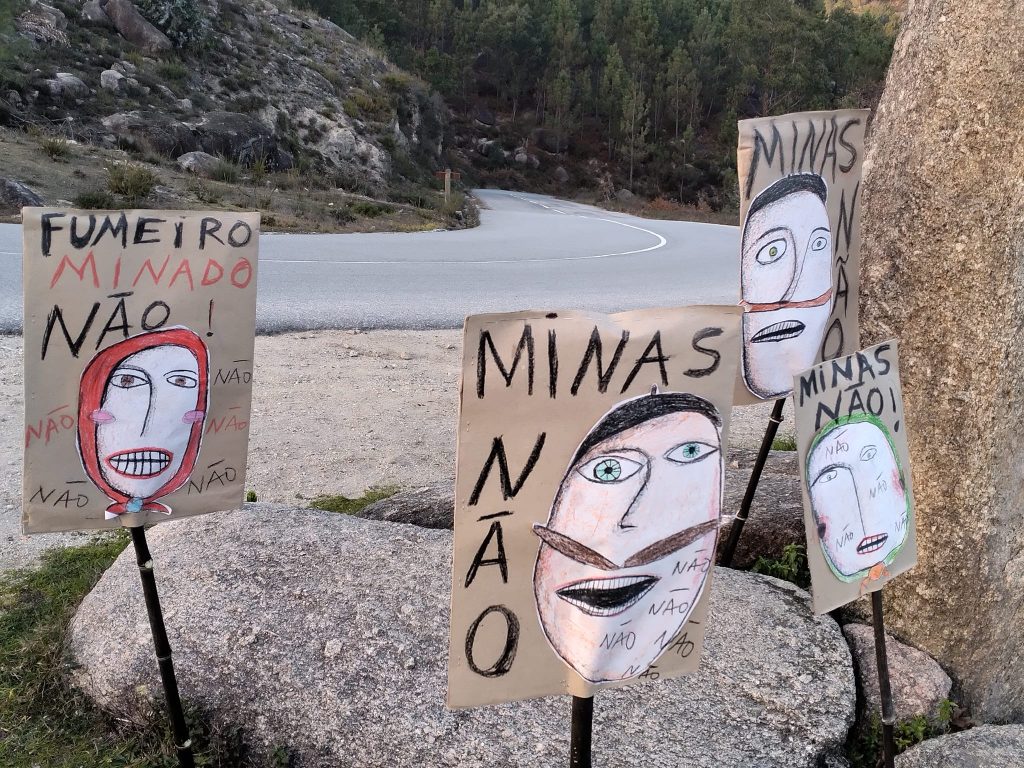
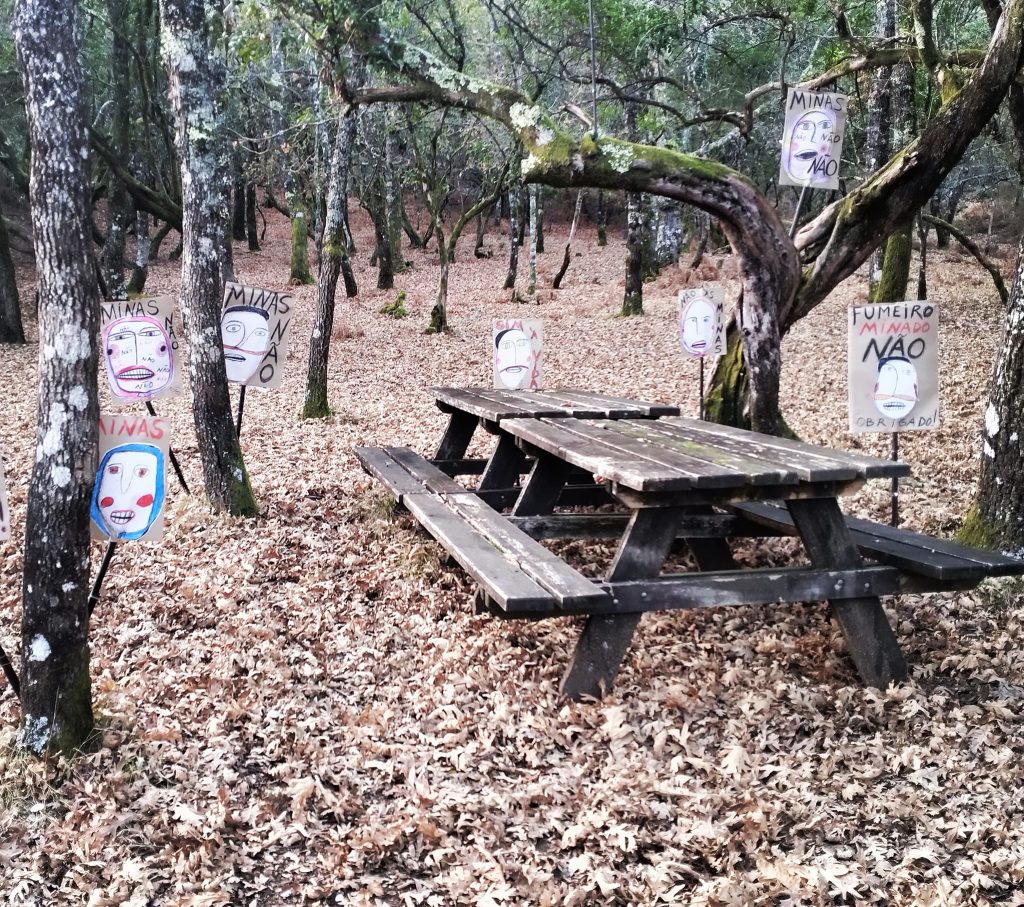
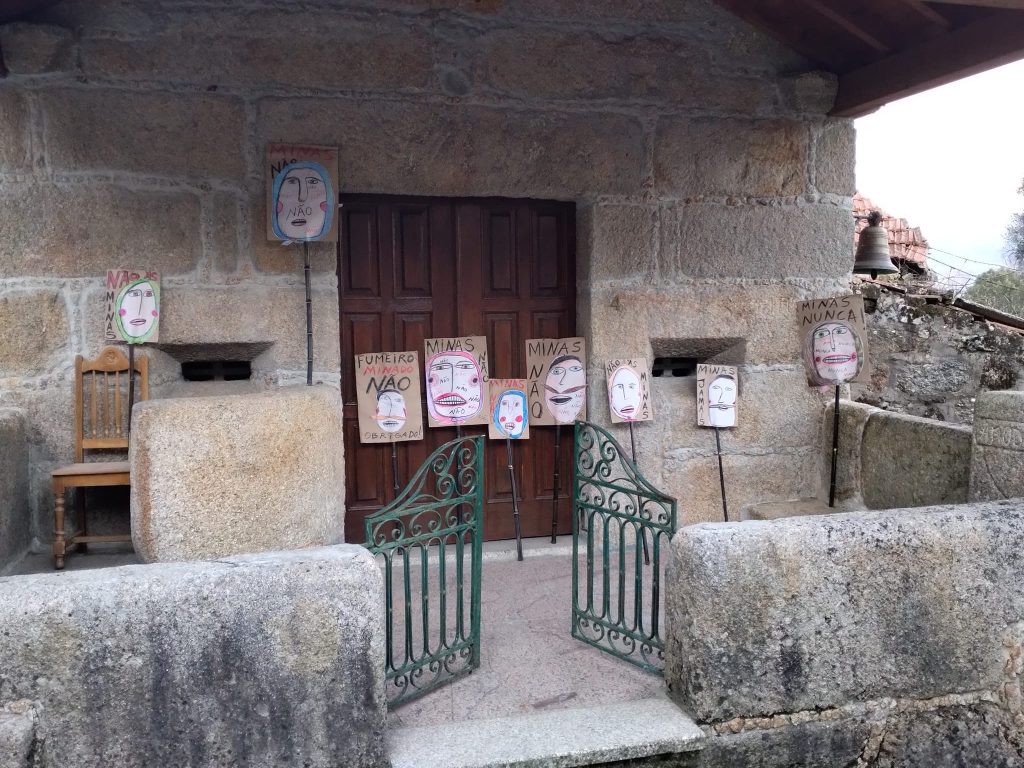
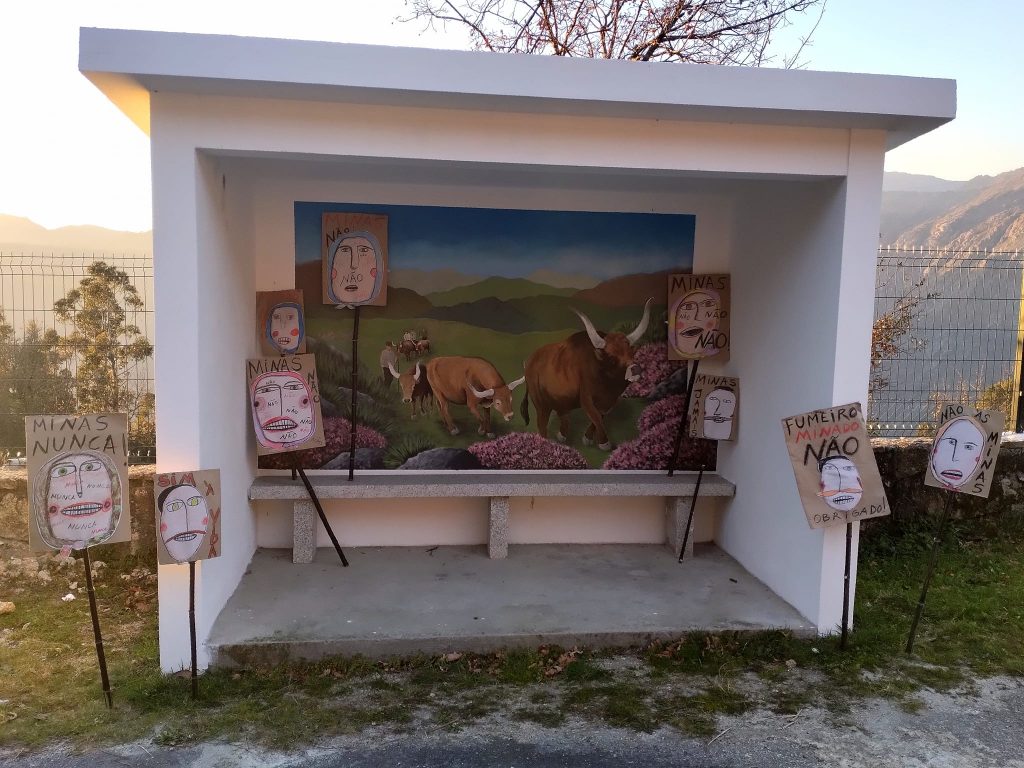
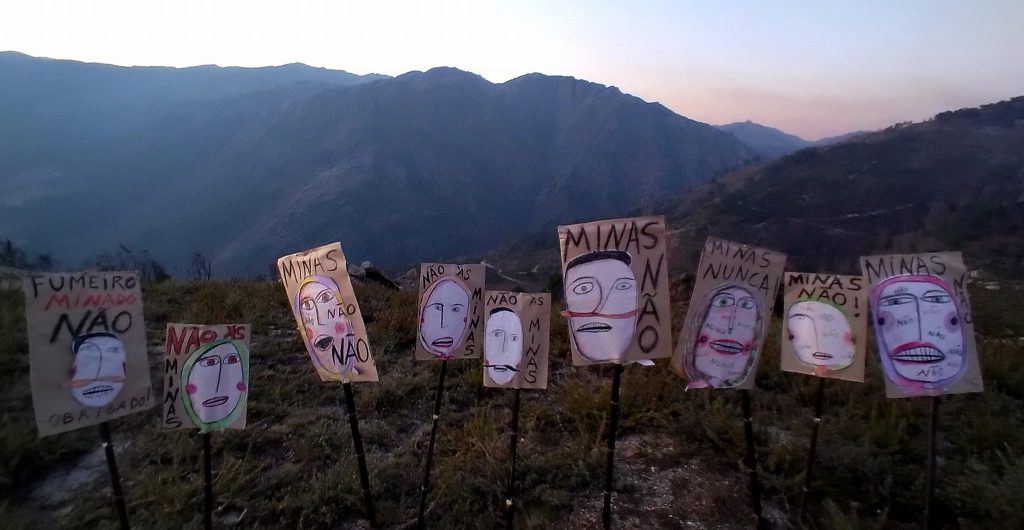
Montemor-o-Novo

The struggle also took to the streets in Alentejo, in the south of the country, where a dozen people gathered in Montemor-o-Novo and walked around the city carrying signs against mining and for the protection of water.

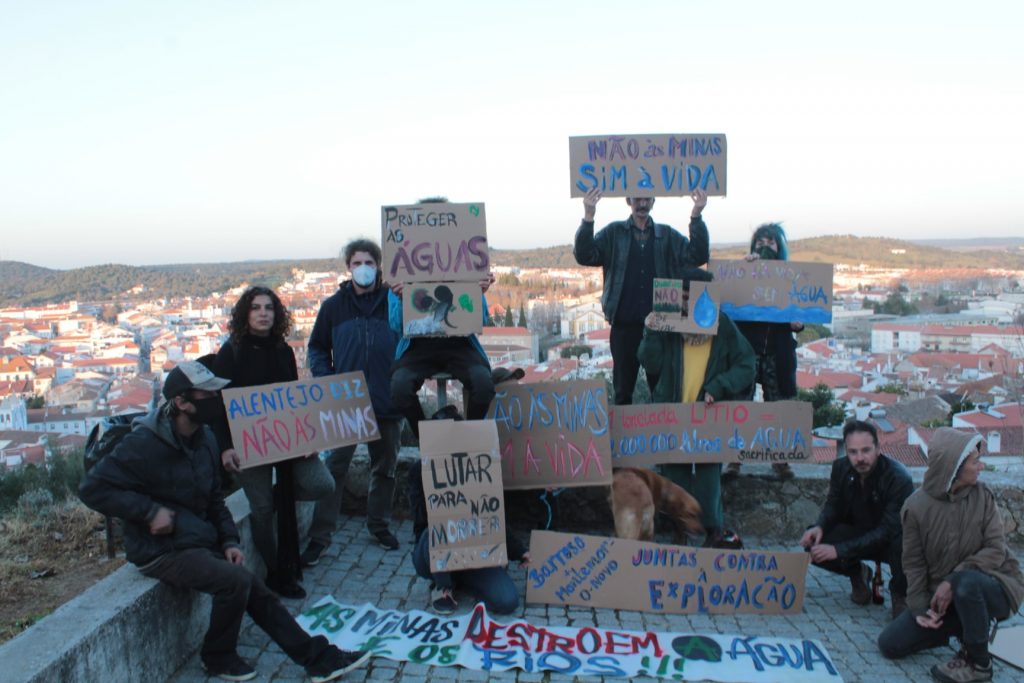
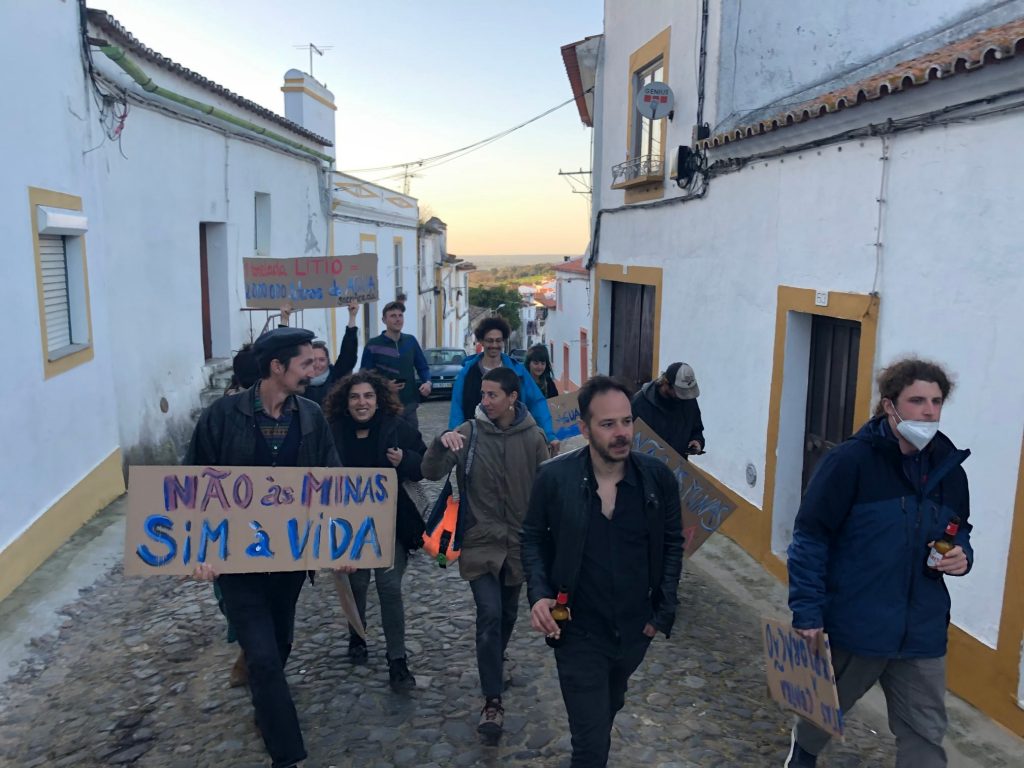
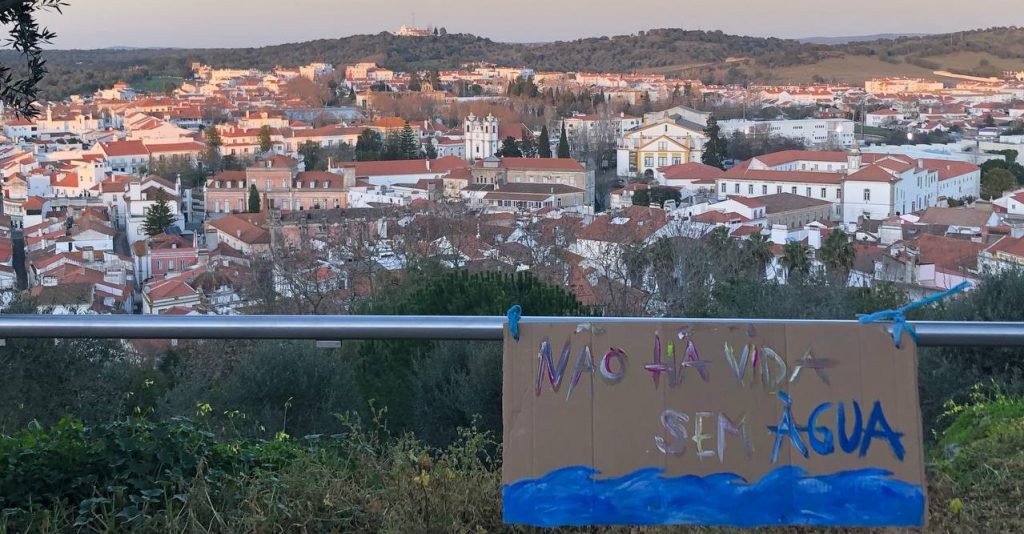
Caldas da Rainha
In Caldas da Rainha, several banners were spread around strategic points of the city.
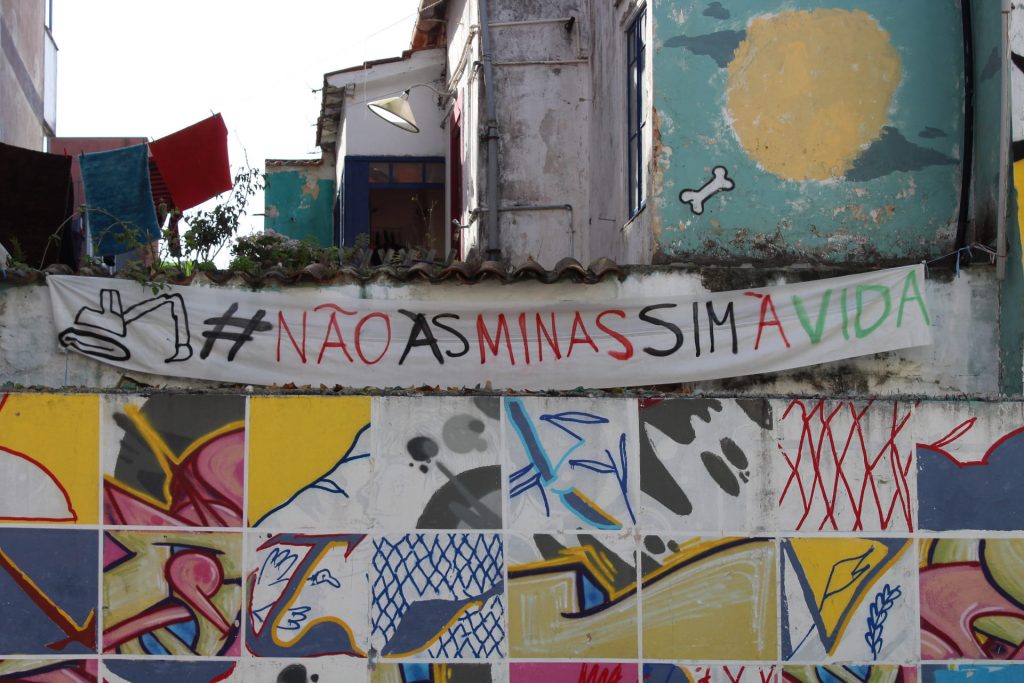


Porto
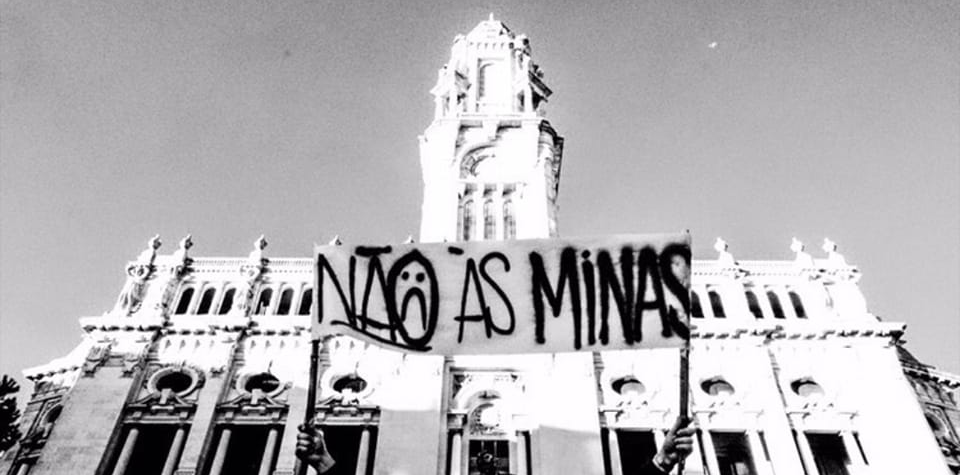
Dozens of people gathered in front of Porto city council to protest the mining plans that threaten the northern region. They also sang the song “Exploração”, by Carlos Libo. Live videos can be seen here, here, here and here.
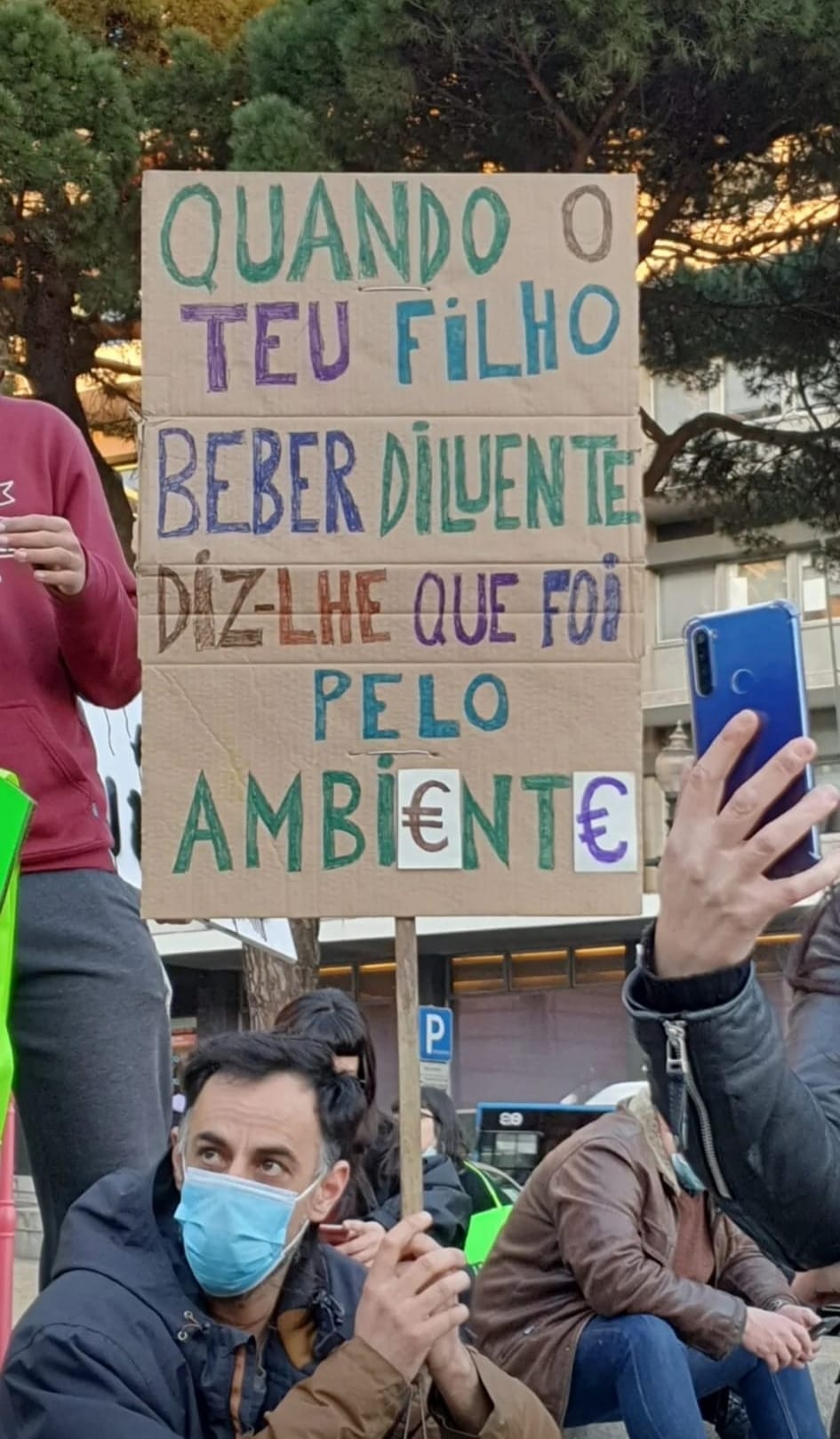

On this day, the faculties of Science and Engineering of Porto (both implicated in the mining development plan) were painted with anti-mining slogans. «If you think this is vandalism, try and see an open-pit mine», say those who organized the action.
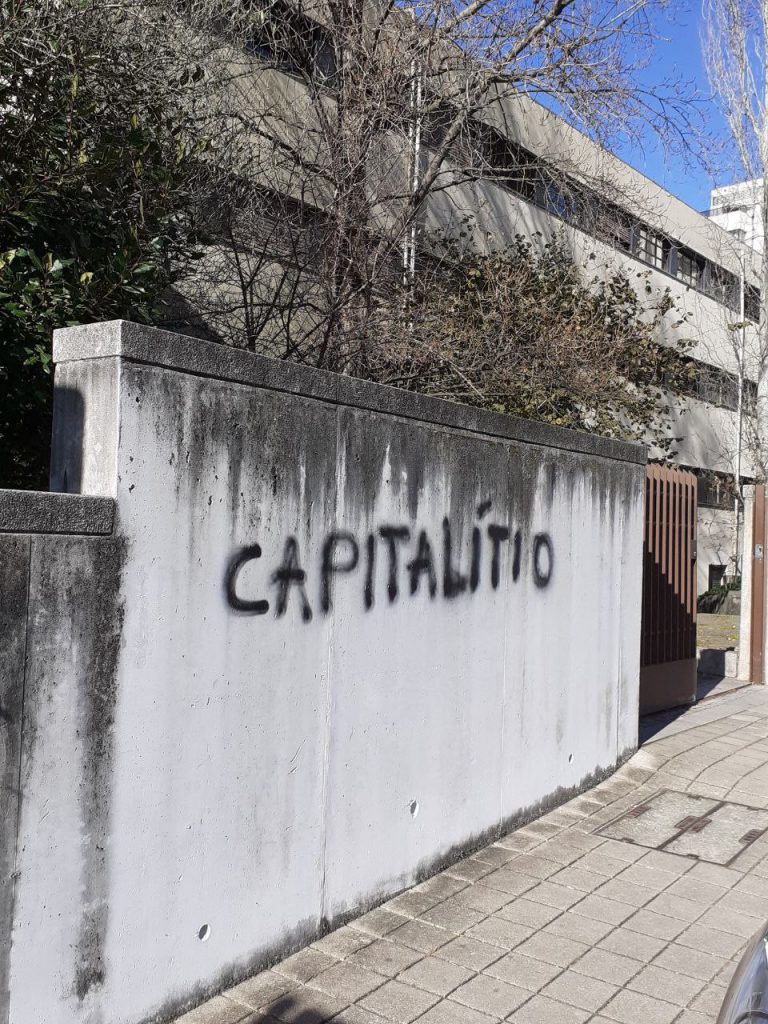
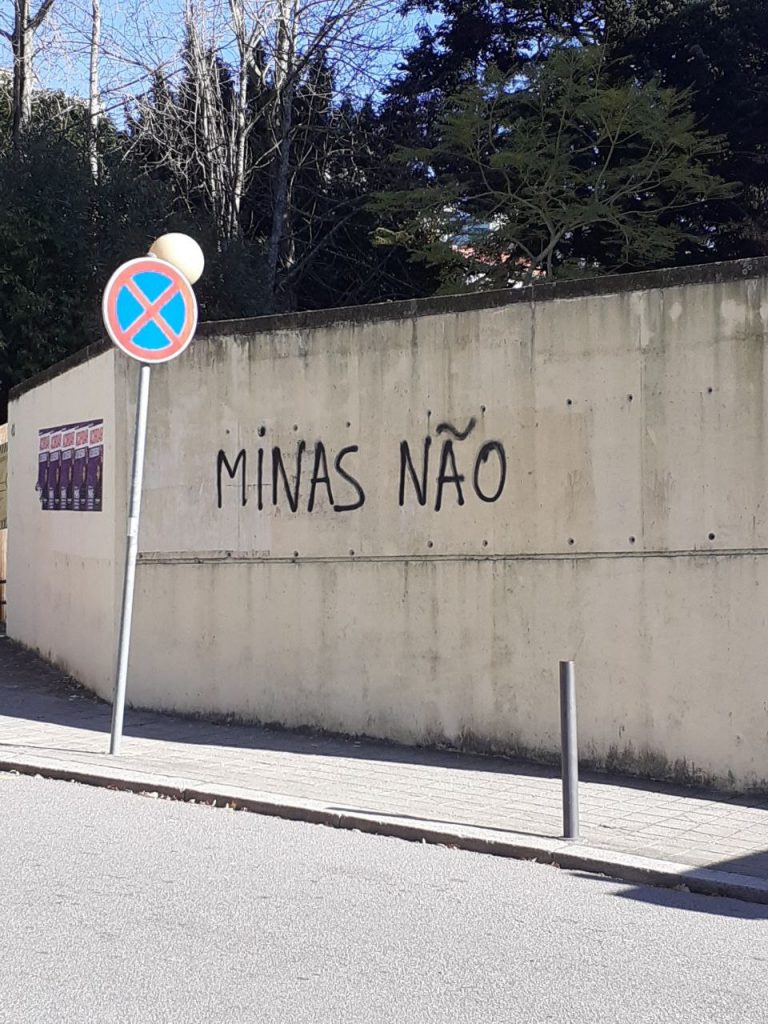
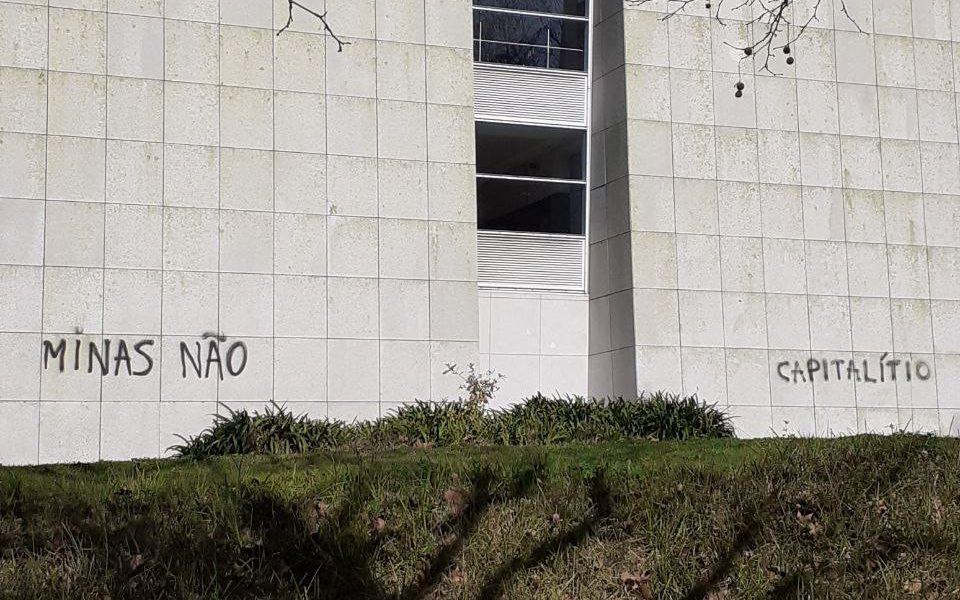
Guimarães

Back north, in Guimarães, posters against mining and in solidarity with Barroso and other regions were spread around the walls of the city.


Sátão
In this village of Viseu region took place a sit-in and flyers with information about the mining plans were distributed to the people. We didn’t find any picture, but it happened!
Remelhe
Smaller and individual actions took place in other points of the territory, for example the village of Remelhe, in Barcelos municipality, from where arrived the following message:

Viana do Castelo
In the walls of Viana appeared several messages oposing mining.

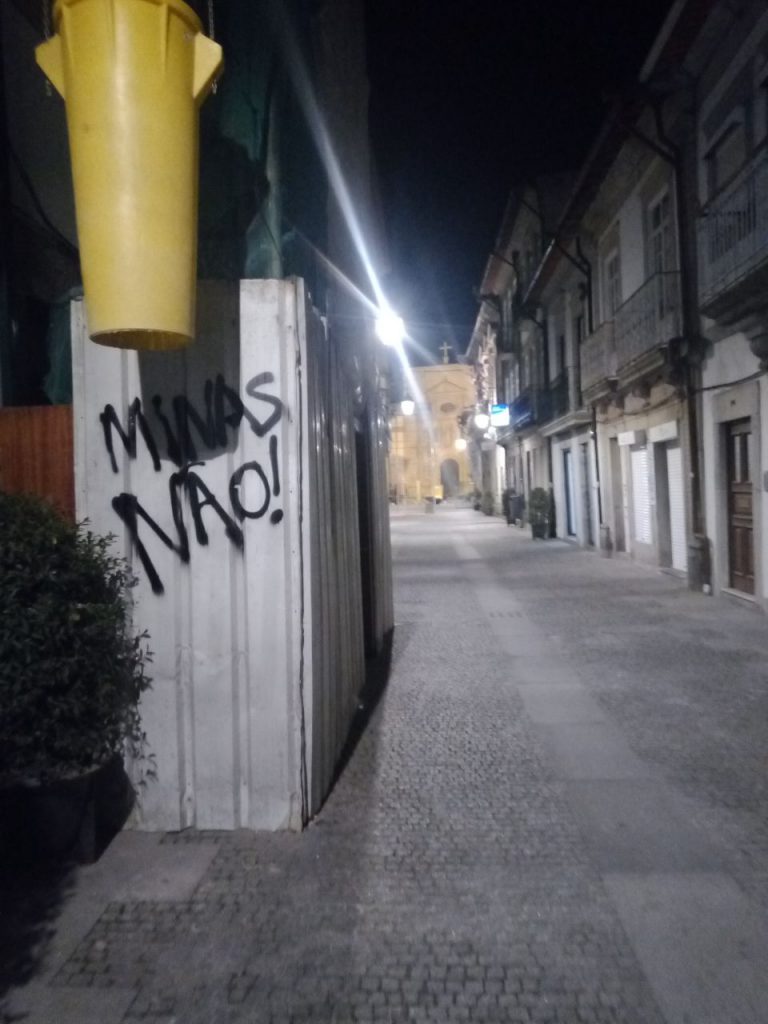
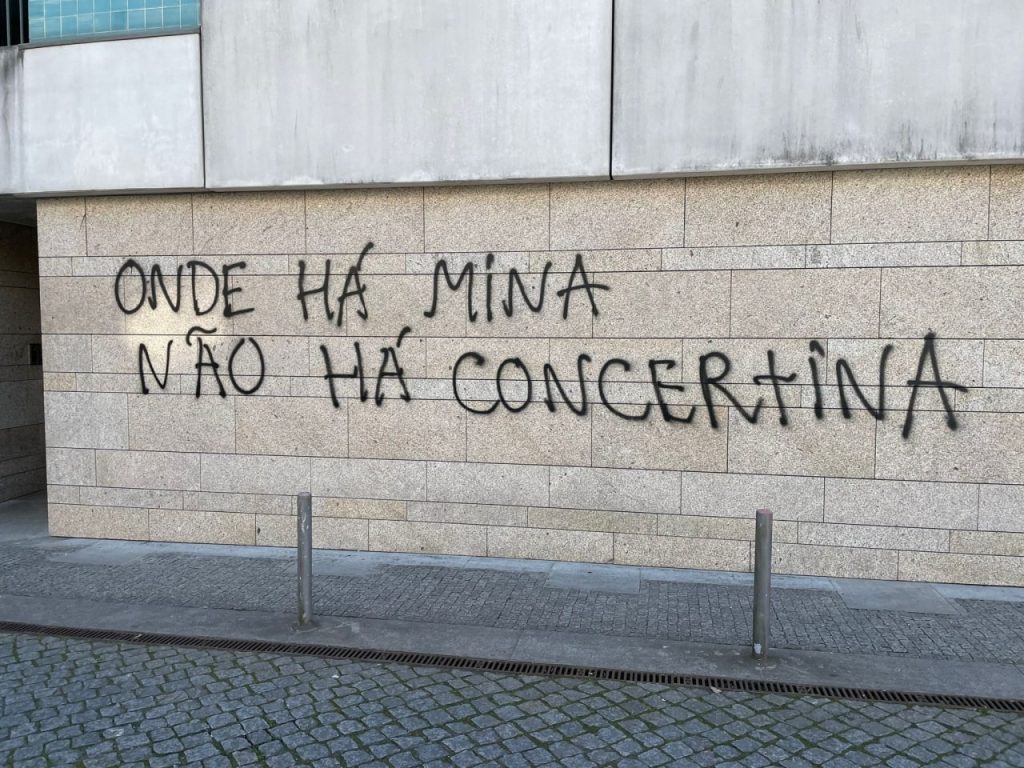
Abroad
In social networks, the movements in Portugal received messages of solidarity from United Kingdom, Ireland, Serbia, Germany and Mexico.
